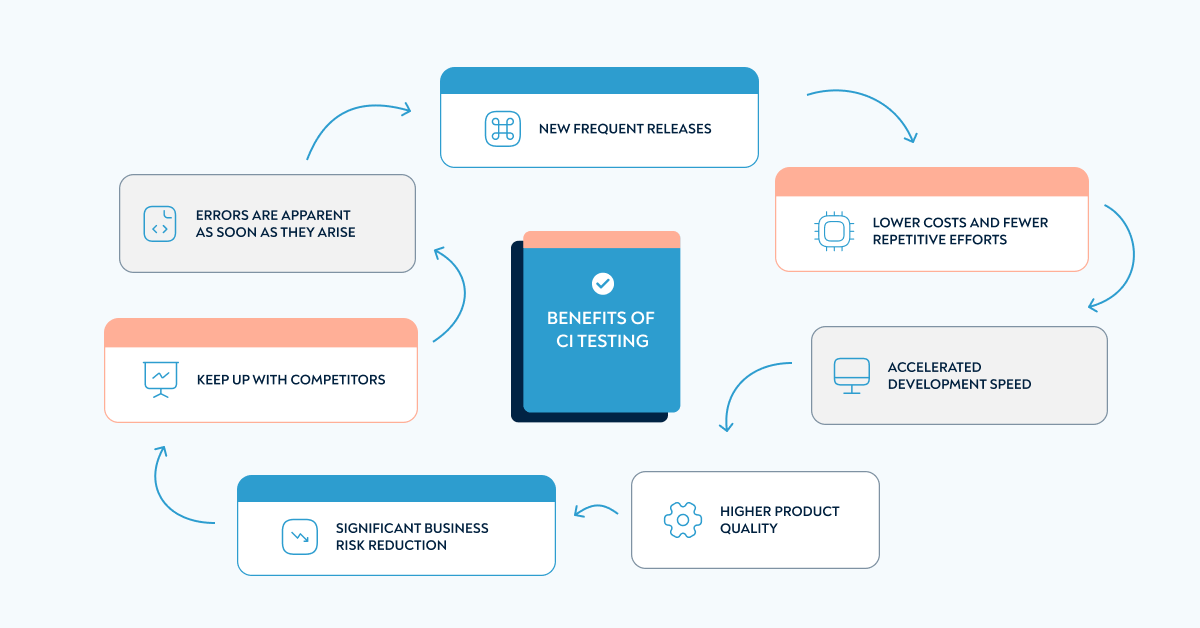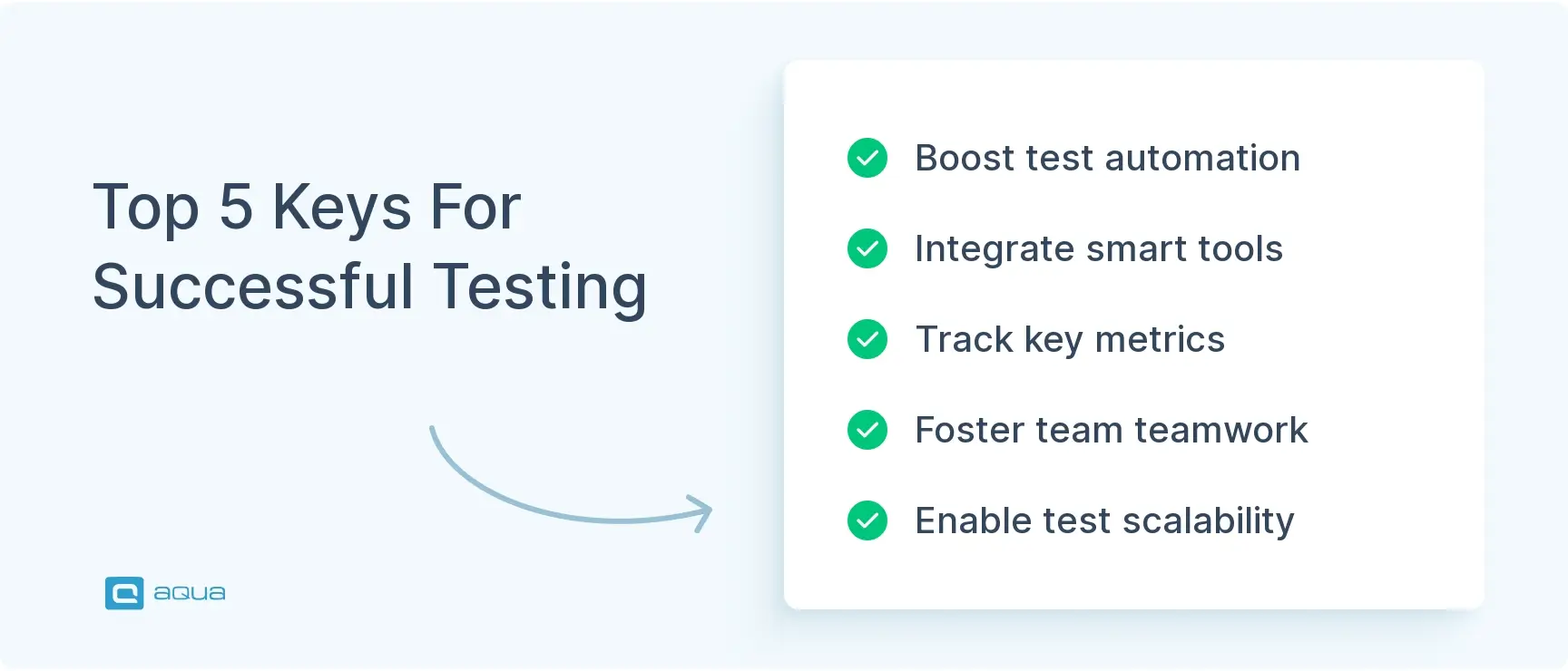Key Takeaways
- Continuous testing integrates quality assurance throughout the entire development lifecycle, providing immediate feedback on risks associated with software releases.
- Automated testing in CI/CD pipelines reduces manual effort by up to 50% while increasing test coverage and accelerating development speed.
- Continuous testing benefits include faster error detection, more frequent releases, lower costs, and significant business risk reduction.
- For successful continuous testing implementation, organizations need increased test automation, integrated tools, comprehensive metrics, team collaboration, and scalable testing.
- Continuous testing enables DevOps teams to switch from sprint-based releases to daily or twice-daily deployments, dramatically reducing lead time.
Many organizations focus too much on development speed and overlook quality risks, but without proper testing strategy, product failures can have severe business impact. Learn how continuous testing solves this challenge 👇
Traditional approaches to enterprise IT, usually based on time-consuming manual processes, have given way in recent years to more flexible, efficient, and result-oriented errors. And with this shift in focus on faster software development cycles, DevOps and Agile methodologies are now essential for any business looking to succeed by discovering digital transformation initiatives.
But many businesses are too focused on this speed and therefore overlook the extremely high level of risk to themselves. The solution to this problem is continuous testing.
Continuous testing
Continuous testing by definition ensures product quality is deeply rooted in every part of the development process, which should be a priority for every business these days, and links testing to continuous delivery. You’re looking at a ticking time bomb if you skip quality checks throughout your development cycle. Teams that don’t measure continuously see production bugs increase massively compared to those running tests at each stage.
You need to set up automated quality gates that block code progression when test coverage drops below 80%. This simple threshold catches roughly 85% of critical issues before they reach users. But there is a hidden cost. A single production defect can eat up 10x more resources to fix than catching it during development. Your best move is starting with just one quality metric today: test coverage, response times, or error rates, and building from there.
Continuous testing tools will take care of this, significantly reducing the time developers get feedback on their actions. Here, tests are found as a built-in part of the software delivery pipeline to provide quick communication checks about the perceived risks associated with the product. This means removing unnecessary processes from your development and software cycles and using new technologies and tools designed for more flexible workflows to achieve higher quality.
Benefits of CI testing

When you implement continuous integration automated testing into your development, you will see how quickly positive changes start. The resulting benefits will bring you closer to achieving your digital transformation goals, such as:
- Errors and new risks become apparent as soon as they arise
- More frequent releases of new updates and products
- Lower costs due to fewer manual resources and fewer repetitive efforts
- Accelerated development speed and streamlined processes
- Tools with greater ease of use and adaptability for the team
- Higher product quality thanks to more detailed metrics and feedback
- Significant business risk reduction
- Ability to quickly respond to new or changing business requirements
- Keep up with competitors
How to perform continuous testing?
Here are some ways to perform continuous testing:
- Using a manual approach:
There are a few essential things whenever changes occur. Ensuring that your test coverage is on par with industry standards allows you to run a test suite to identify and mitigate any failures. You can also utilise a bug reporting tool for these purposes.
Having clear, concise and well-defined processes is crucial, primarily when your test suites aren’t fully implemented or automated. Moreover, these processes ensure all changes are confirmed through regression testing before being released into production.
- An automated approach:
By using a continuous integration server as your test automation tool, you can efficiently run automated tests. There are a few ways we can save time and ensure our changes have been adequately tested. Prior to release, testers can run their tests automatically and display their results. You can also read our article “What is test automation tool?” to find the best automation tools.
By providing an automated approach to managing QA, continuous testing makes interactions between workflows at each stage of the software development life cycle (SDLC) flawless.
Developers receive information for improvements in the compatibility and performance of their code before it’s deployed on time due to the timely integration of continuous feedback loops into user and unit test modules.
This efficient collaboration exterminates any disconnection between team members, accelerating software delivery.
The continuous test ensures a confident release and gives you peace of mind that you have high-quality software, regardless of your chosen approach.
How continuous testing works within DevOps/DevSecOps
Continuous testing is an integral component of DevOps. It is what elevates DevOps from hamster wheel racing to the smart effort of automatically deploying new code as quickly as possible.
For DevOps, you will be using the automated approach to continuous testing. Once the development team signs off new code, it enters a loop of automated tests to see if it is production ready. With a good setup, you will get a test report either green-lighting the code or rejecting it. The better error detection you have, the more likely you are to know the probable issues straight from the code.
There are a couple of useful techniques to improve continuous testing. First, ask and even help your devs to implement unit testing. This will both save their time on code reviews and increase the quality of code that reaches the automated testing phase. Then, make your tests self-heal so they automatically adjust to UI and text changes. Self-healing is a feature frequently found in AI-powered testing tools.
As for DevSecOps, continuous testing gets more significance for a slightly different reason. While traditional DevOps values it for speed, DevSecOps benefits from extra precision. Automated tests eliminate the human factor where they can, providing the safety that DevSecOps preaches.
Continuous testing methodologies
Continuous testing is an approach to quality assurance rather than a special type of testing. That means you’re picking between or combining the same methodologies. These include Waterfall, Agile, and Xtreme Programming. The rule of thumb is to go with the same methodology that your team observes.
That being said, continuous testing enables QA and thus the build cycle to be much more iterative. Our team switched from Scrum sprints to Kanban releases that happen every day if not twice a day. Just like devs, testers now tackle one task at a time and get it production-ready. This dramatically reduced our lead time and could prove the right choice for you.
Shift-Left and Shift-Right Practices in Continuous Testing
Quality needs to thread through your entire development cycle.
Here’s how the shift-left, shift-right approach works: You start catching issues when they’re cheap to fix. Run static code analysis and unit tests right alongside your development work, not after. But don’t stop there, shift-right takes testing into production itself. Think canary deployments that slowly roll features to real users, or feature flags that let you test in live environments without breaking things.
Set up automated unit tests that run on every commit (that’s your shift-left foundation), then add real user monitoring to catch what automated tests miss. You’ll build a feedback loop that makes your releases both faster and more reliable.
Top 5 Keys For Successful Testing
- More test automation
One of the main elements of a successful testing strategy is continuous integration test automation. This kind of automation improves test and error coverage and boosts the speed of releases.
- Integration of tools
Proper tools can make automation of your testing easier and they also can solve other problems — reduce manual efforts, gather and verify test results, and cut down redundant actions.
- Comprehensive metrics
You need more than basic pass/fail numbers to see what’s really happening with your testing pipeline. Start tracking deployment frequency and lead time for changes alongside your usual defect counts – these DORA metrics will show you patterns that basic QA stats miss entirely.
Throw in the mean time to recovery and change failure rate to your dashboard, then watch for defect escape rates creeping above 5%. Most teams overlook test flakiness as a metric, but it’s often the canary in the coal mine for deeper pipeline issues.
Your first move should be setting up automated tracking for at least three of these indicators, as manual collection kills the whole point of real-time visibility into your delivery performance.
- Encourage collaboration
Make sure that both developers and testers have a common ground about the level of quality they need to provide. Encourage transparent and respectful collaboration between teams as it helps to keep the work environment efficient.
- Scalability of testing
The more code the more test coverage you need which requires expanding your storage capacity for CI tests. Make use of an ALM software testing tool to reduce test times as much as possible. aqua cloud provides true limitless scalability for better test coverage.
Smart Toolchains and Scalable Test Environments
Your testing setup needs to grow with you and the right toolchain makes that possible. Smart teams run tests parallel to builds using Docker and Kubernetes, then spin up fresh test environments instantly with Infrastructure as Code. Cloud platforms handle the heavy lifting when your test suite explodes in size.
Real-time API connections between your test management and CI/CD pipeline actually moves the needle. This gives you unified dashboards that cut decision time nearly in half. AI tools are getting scary good at fixing broken test scripts automatically and cherry-picking which tests to run based on code changes.
Start simple and containerise one test environment first, then expand. Teams that nail tool interoperability can scale QA across distributed teams without the usual coordination headaches. The payoff is, your quality process stays rock-solid even when your team doubles overnight.

Conclusion
Continuous testing strategy has a lot of advantages allowing you to check the quality of the code immediately after submission whether you use an automated continuous performance test, CI testing or not. It makes a huge contribution to the quality of your software with much more depth and coverage, with more incredible speed and accuracy than can be achieved with any other testing.


















